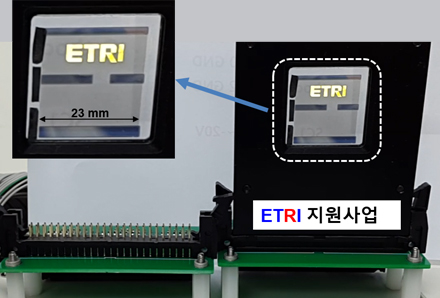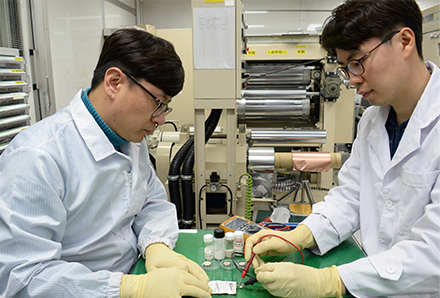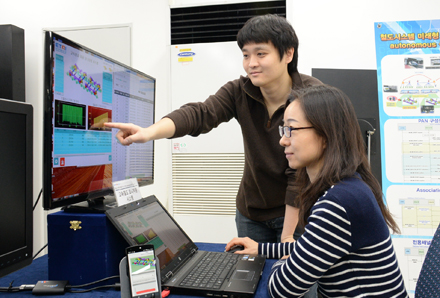
OLED and Graphene Improve Transparency and Image Quality
Researchers of ETRI have developed a core technology to replace the thin metal-based electrodes used as transparent electrodes for OLEDs with graphene-based electrodes to allow enhanced transparency and reduced reflectance.
The metal electrodes used thus far for OLEDs have largely been made with silver, and they provided a limited viewing angle due to their internal light reflection. The external light reflection is also responsible for affecting the image quality.
In an effort to fundamentally address the issue, the researchers decided to use graphene, which has little internal and external light reflection, and improved transparency by 40 percent and reflectance by 60 percent. They also applied the new technology to create a film with 23 mm width and length and 30 µm thickness and successfully tested the performance of an OLED by attaching a graphene transparent electrode on the organic layer.
This achievement was published in Scientific Reports, a sister journal of Nature, on December 2, 2015. It is expected that when this technology is applied to transparent OLED displays and large-size OLED displays based on white OLEDs, it will significantly improve transparency and image quality.
In particular, unlike traditional vacuum-based OLED manufacturing, the new technology allows the use of a lamination method to attach films onto organic layers and graphene. As a result, OLED displays can be manufactured with a simpler process, and the technology will gradually develop into a manufacturing technology involving roll-to-roll processing in the years coming.
Dr. Jeong-ik Lee, the head of the Soft I/O Interface Research Section, stated that “at a time when the OLED industry in Korea is facing harsh competition with latecomers, the new technology will contribute to widening the gap with our competitors.”

New Technology to Produce Solid Electrolyte for Lithium-Ion Batteries
A joint research team participated by Dr. Young-Gi Lee of ETRI’s Power Control Device Research Section and Prof. Kisuk Kang of Seoul National University has developed a LLZO solid electrolyte.
Published in Scientific Reports on December 15, 2015, this achievement is expected to be effectively used for batteries for electric automobiles that require a high level of security, large-scale military energy storage systems, and batteries for wearable devices that have direct contact to human body.
The researchers increased the ionic conductivity based on faster lithium-ion movement and at the same time significantly reduced the time spent and cost for high-temperature heat treatment by exploiting the multi-doping technology with a considerable synergy effect.
The research team doped two different elements with a mutual synergy effect into LLZO and dramatically reduced the time for high-temperature heat treatment to two hours, which is about one-twelfth of the time required thus far. As a result, compared to the case without doping, the ionic conductivity was found to have increased by more than three times.
The researchers will now focus on developing and mass-producing lithium-ion batteries that directly work based on a solid electrolyte. Full commercialization is expected to be realized in five years, and the remaining task is to improve the performance compared to batteries using a liquid electrolyte.
The latest achievement also provides an advantage to battery design, since the solid electrolyte maximizes the energy density within a battery whereas its liquid counterpart creates empty space within a battery.
Dr. Dong Ok Shin of ETRI’s Power Control Device Research Section and the first author of the research paper remarked that “this achievement is of significance in that we have developed a solid electrolyte, a core element of next-generation lithium-ion secondary batteries, by finding a way to ensure outstanding stability and improve ionic conductivity.”

Power free IoT Technology ensuring train safety
To ensure the safety of high-speed trains, ETRI has developed a convergent IoT (Internet of Things) technology which monitors the status of a train’s moving parts in real time and transmits the measured data to the train control center through a wireless network.
As part of a convergent research project sponsored by the National Research Council of Science and Technology, ETRI and the Korea Railroad Research Institute announced on December 21, 2015, that they have successfully developed a convergent IoT technology to effectively prevent derailment. This technology monitors the status of a train’s moving parts in real time through an IoT sensor attached on high-speed trains to detect vibration and heat and then transfers the data to the train control center through a wireless network.
The main cause of derailment is either abnormal high degree of heat generated from a wheel’s bearing in the axis or severe vibration. Although the bearing temperature is currently measured along with the rail tracks at every intervals of 40 kilometers and any abnormal status is reported through a wired network, it remains difficulty to ensure continuous monitoring. In order to advance this issue, the researchers developed 70 mW low power consumption IoT wireless sensors operated by energy harvester power without external power supply, and installed it to every train car. Also this IoT sensor consists of RF integrated circuits(RFIC) customized for a railway wireless environment and low power FPGA. After gathering the measured data, sensor coordinator and Wi-Fi relay transfer these data to the locomotive engine. They also developed an wireless sensor gateway equipment which transfer the sensing data to the Internet networks. Any problems from wheels are alerted with an alarm on smart phones or computers for real-time monitoring.
The research team successfully demonstrated the IoT sensing data delivery technology to the train control center through the commercial 3GPP/LTE network.
When applied to actual trains, this technology is expected to reduce the maintenance expenses of 60 billion won from total annual maintenance cost 600 billion won saving of up to 10 percent.
Dr. Young-il Kim, who led the research team, introduced his plan to organize a joint research consortium with MTZ (Mongolian Railway) and Mongolian University of Science and Technology including bilateral companies and proceed with technology transfer in order to apply the related technology to Mongolian railway.